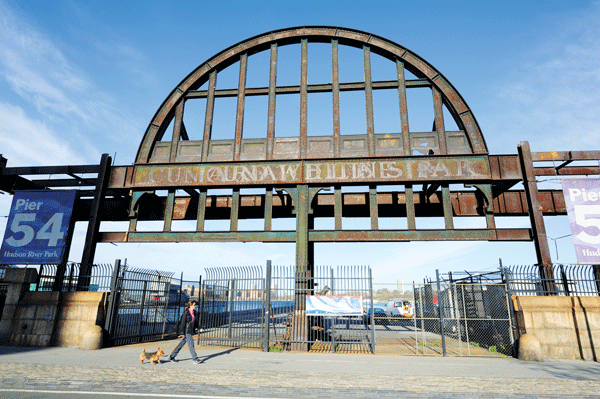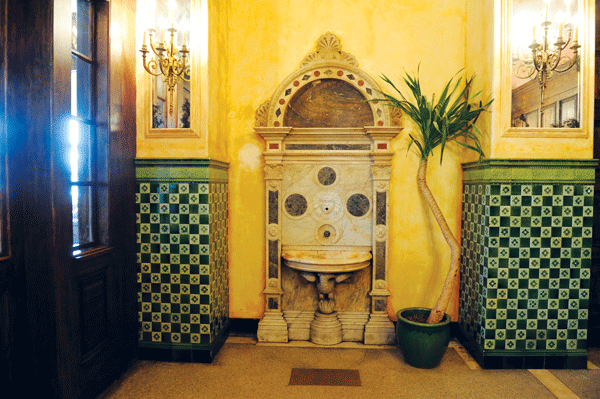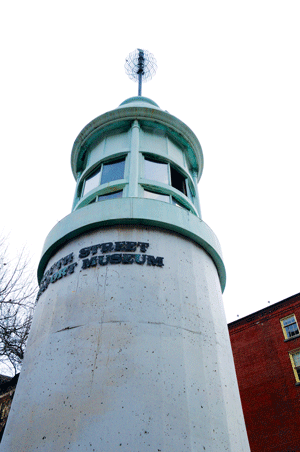 [/media-credit]
[/media-credit]
- Faded paint on the arch at the entrance of Pier 54 on the Hudson River near 13th St. shows that it was once used by the White Star Line and by Cunard White Star. The Titanic’s survivors were brought to this pier on April 18, 1912. The arch is the remnant of the pier shed that once covered the structure.
BY TERESE LOEB KREUZER | It will be 100 years come April 15 since the opulent ocean liner Titanic hit an iceberg off the coast of Newfoundland and sank at 2:20 a.m., killing more than 1,500 people. But not all vestiges of that tragedy are at the bottom of the Atlantic Ocean. Some are in Manhattan.
The arched ironwork at the entrance to Pier 54 on the Hudson River near W. 13th St. still bears the words “Cunard White Star Line” in faded paint. This was the pier to which the Carpathia, a Cunard ship, brought the survivors of the Titanic, docking there on April 18, 1912. A few blocks north, at Pier 59, in what is now the Chelsea Piers sports complex, the Carpathia stopped off at the White Star moorings to deposit the lifeboats that had saved the lives of 705 people.
Then around 100 members of the bedraggled, exhausted crew of the Titanic were taken down Manhattan’s Lower West Side to what was then the American Seaman’s Friend Society, now The Jane hotel, at 113 Jane St., where they received clothing, food and lodging.
 [/media-credit]
[/media-credit]
- The faded floor plaque that hipsters pass in front of this fountain in The Jane hotel’s lobby is a memorial to the Titanic disaster. The ill-fated ship’s surviving crew members were taken to the building.
The exterior of The Jane probably looks much as it did then. The interior has been revamped, but two items in the lobby recall the Titanic and its time — an ornate, marble fountain that was there when the survivors arrived and a metal plaque that was subsequently placed in front of it, now so worn that the inscription can no longer be read.
What is now the ballroom and bar of the hotel on the right side of the lobby was at that time a little assembly hall. The surviving crew gathered there on April 19, 1912, to pray for those who had been lost. An article in The New York Times published the day after described the service. The men cried as they prayed. Then, accompanied by Miss Josephine Upham on the piano, they sang “Nearer My God to Thee” and “Rock of Ages.”
Afterward, over coffee and sandwiches, some of the crew talked about their experiences. They said that they had never had a dress rehearsal with the lifeboats since the ship left Southampton, England, on April 10. In fact, it emerged subsequently that there were only enough lifeboats for one-third of the people onboard.
They also talked of horrors beyond the sinking of the ship itself.

“One told of hearing as many as twenty shots fired amid all the groans and cries that rose as the Titanic went down,” the article said. He thought the shots were suicide shots. “One told of a frantic swim for the raft that was soon so crowded that they had to beat men off. One who climbed aboard had on a soldier’s uniform. He lay down on the raft and died and they pushed him off to make room for the living.”
Among those who survived the sinking was J. Bruce Ismay, managing director of the White Star Line, who secured a place for himself in a lifeboat and was socially ostracized for the rest of his life because of that. Only one-third of the men traveling in first class were saved. The rest elected to give their places to the women and children. Colonel John Jacob Astor, one of the richest men in the United States, if not the world, was among those who perished. He is buried in Trinity Church’s uptown graveyard at 155th Street and Broadway.
Others who drowned included two Catholic priests. They boarded the Titanic in Queenstown, Ireland, and spent most of their time in steerage, ministering to the Irish immigrants on the ship. The Times reported, “George M. McGough, an able seaman on the Titanic who manned one of the lifeboats, told yesterday [April 19, 1912] at the Catholic Seamen’s Mission at 422 West St.” that the two priests “spent their last two hours consoling the people of the steerage and finally went down with the ship.”
Some of the people in steerage survived. The women were taken to the Mission of Our Lady of the Rosary at 7 State St. in Lower Manhattan. Among the Irish immigrants was a young woman named Ellen Shine. New York City Council Speaker Christine Quinn is her granddaughter. Today, the mission is known as the Parish of Our Lady of the Rosary and shares space with the St. Elizabeth Seton Shrine, which will soon open an exhibit about the mission and its work.
Stories about the Titanic are a mixture of horror and heroism. The heroes would have to include Harold Bride and Jack Phillips — the Marconi operators aboard the ship. “Wireless telegraphy,” or radio, was relatively new at that time, and of course, the Titanic was equipped with the newest technology. When the Titanic’s captain, Edward J. Smith, realized that the ship was sinking, he told Bride and Philips to send messages to neighboring ships to ask for help. Between 12:15 a.m. and 2:17 a.m., the increasingly desperate messages went out and then abruptly ceased. Bride was saved. Phillips perished.
A memorial in Battery Park to maritime wireless operators who died in the line of duty is inscribed “Jack Phillips, S.S. Titanic, April 15, 1912, Atlantic Ocean.” Because of extensive construction in the park, the memorial is currently in storage, but it will return to the park.
The first reports of the sinking of the Titanic said that all aboard were saved. Soon it became clear that this wasn’t true. Aching for news, thousands of people swarmed around the White Star office at 9 Broadway, across from Bowling Green park. The news came in by wireless. One of the receiving sites was on top of the tall John Wanamaker department store at Eighth St. and Broadway, where American Marconi had a station. A young man named David Sarnoff was the manager. As he later told the story, “It happened that I was on duty at the Wanamaker station in New York and got the first message from the Olympic, 1400 miles out at sea, that the Titanic had gone down.” He said that he stayed at his station for 72 hours as the news emerged. “I passed the information on to a sorrowing world,” he said. Sarnoff, himself an immigrant from Belarus, was promoted after the Titanic disaster — a stepping stone in a career that culminated in his becoming president of the Radio Corporation of America (RCA).
At the corner of Fulton and Water Sts. in the South Street Seaport, is a lighthouse that once stood on top of the Seamen’s Church Institute at the corner of South St. and Coentie’s Slip. It was erected by public subscription in 1913 as a memorial to those who had died on the Titanic. From 1913 to 1967, a ball at the top of the lighthouse dropped down a pole every day at noon to signal the time to the ships in the harbor. The time ball was activated by a telegraphic signal from the National Observatory in Washington, D.C. In July 1968, the Seamen’s Church Institute moved to 15 State St. and the Titanic Memorial Lighthouse was donated to the South Street Seaport Museum. It was moved to its present site in May 1976.
On April 10 — 100 years to the day from the Titanic’s departure from Southampton, England, on her maiden and only voyage — the South Street Seaport Museum is opening an exhibit in its Melville Gallery on Water St. that will feature rarely seen historic documents from the Titanic and her passengers. The exhibit will also show how the sinking has been interpreted and remembered in popular culture.
No matter how many times the Titanic story is told, it doesn’t lose its haunting power.

















